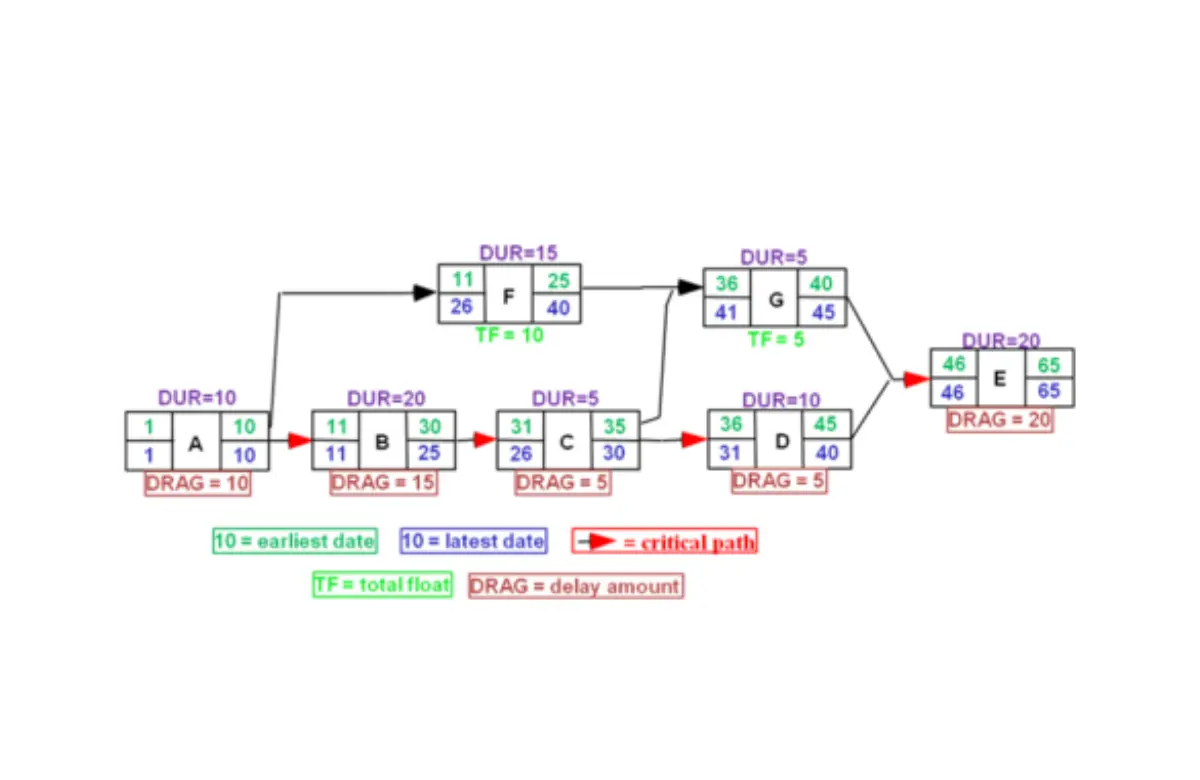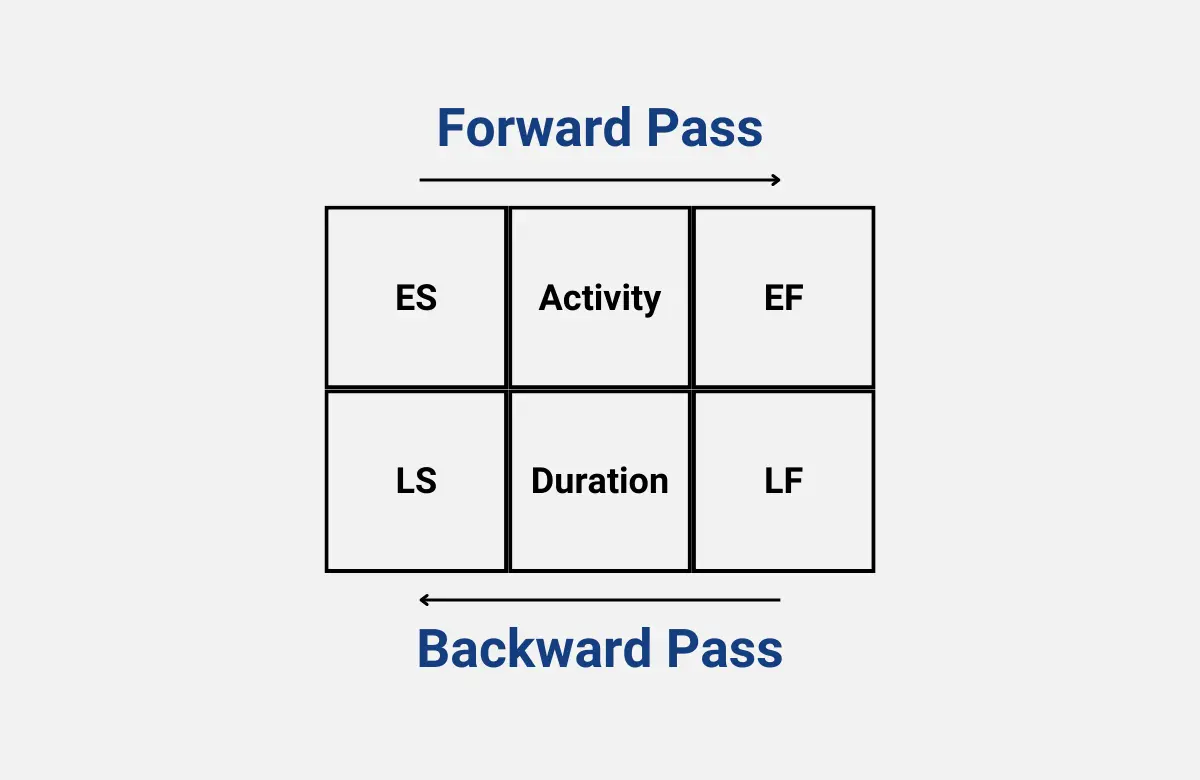As a project manager, developing an optimal project schedule is critical for on-time delivery.
Forward pass in project management is an essential technique for determining the early start and early finish dates of activities in your project schedule management plan.
By calculating the earliest possible start and end times for each activity, you can build a realistic project schedule that identifies the critical path which is the sequence of dependent tasks that determines the overall project duration.
In this article, we’ll cover what the forward pass technique is, how to perform it on a project network diagram, and its importance in scheduling projects and optimizing workflows.
What is Forward Pass in Project Management?
Forward pass in project management is used to determine the earliest possible start and finish times for activities within a project schedule network diagram.
It involves analyzing the diagram from left to right to calculate the early start and early finish dates for each activity based on predecessor dependencies and durations.
Specifically, the early start date of an activity is the earliest date it can begin based on the early finish of its predecessor activities. The early finish date is its early start plus the activity duration minus one day.
This data enables you to estimate the total project duration and build an optimal timeline.
The forward pass is conducted before the backward pass, which calculates late start and finish dates, to jointly provide comprehensive insights for critical path analysis.

Schedule Network Diagram in Project Management
The project schedule network diagram visually depicts the logical relationships and sequences between project activities.
It represents the workflow and activity dependencies needed to complete the project.
This diagram serves as the foundation for conducting forward and backward passes to determine activity start and finish dates.
Developing a comprehensive schedule network diagram with accurately defined precedence relationships is essential for realistic project timelines as it enables effective schedule analysis using critical path and float calculations.
How to Calculate Early Start and Early Finish
The early start (ES) is the earliest possible date an activity can begin based on the schedule network logic and predecessor dependencies.
For the first activity, ES is the project start date, while for other activities, the ES is the highest early finish date of its predecessor activities
The early finish (EF) is the earliest possible date an activity can be completed. It is calculated as:
EF = ES + Activity Duration – 1
For example, if Activity A has an early start of Day 1 and a 5-day duration, its early finish will be Day 1 + 5 – 1 = Day 5.
Understanding early dates is crucial for building project schedules. Focusing on the ES enables you to allocate resources as early as possible and tracking the EF allows you to monitor if activities finish on time.
Any delays in early finish dates can indicate problems that require intervention. The early dates determine the total project duration and help identify the critical path.
Activities on the critical path have zero float and directly impact the schedule if delayed. Knowing the ES and EF dates enables you to optimize schedules, plan effectively, and minimize risks.
Float in Project Management
Float, also called slack, refers to the amount of time an activity can be delayed without impacting the overall project schedule.
It is calculated during backward pass analysis as the difference between an activity’s late start and early start dates, or between late finish and early finish.
Critical path activities have zero float. But non-critical activities often have float, which indicates flexibility in their start and finish times.
You can leverage float to optimize resources and deal with roadblocks. Activities can utilize float time if preceded by delays, without extending the project timeline.
Monitoring float also enables proactive risk mitigation by buffering activities susceptible to delays. Thus, determining and monitoring float through backward pass analysis is key for creating resilient project schedules.

Importance of the Forward Pass Technique
The forward pass technique is critical for successful project management. Analyzing activity sequences and predecessor dependencies provides invaluable schedule insights.
Here are key reasons why mastering the forward pass technique is essential:
1. Determines Project Duration
Conducting a forward pass allows you to calculate the total project duration based on early finish dates of critical path activities which provides visibility into overall timelines and key milestones.
2. Enables Realistic Scheduling
By considering predecessor dependencies and resource constraints, forward pass analysis allows the creation of pragmatic schedules. This helps minimize unrealistic timelines that cause delays.
3. Facilitates Resource Planning
Knowing early start and finish dates for activities enables more efficient planning and allocation of labor, materials, and other resources which helps in optimizing resource utilization and avoiding bottlenecks.
4. Identifies the Critical Path
The forward pass reveals activities with zero float that are critical for on-time delivery. You can prioritize resources for critical path activities to avoid project delays.
5. Allows Schedule Optimization
Using the float and timeline insights from forward pass, you can compress schedules by crashing or fast tracking activities which facilitates the optimization of workflows.
6. Provides Monitoring Visibility
Tracking early finish dates allows greater visibility into activity progress. Delays can be identified early for proactive intervention to keep projects on track.
7. Enables Risk Mitigation
By pinpointing schedule flexibility, forward pass allows buffering high-risk activities with float to proactively mitigate risks of delay.

How to do a Forward Pass in Project Management
Follow these key steps to perform a forward pass analysis on your project schedule network diagram:
Step 1: Create the Schedule Network Diagram
First, create a detailed project schedule network diagram depicting all activities and their dependencies.
Outline the sequence of activities and predecessor relationships required to complete the project.
Step 2: Estimate Activity Durations
Determine realistic duration estimates for each activity by considering the scope of work, resources required, and historical data.
Document the estimates in the activity boxes.
Step 3: Assign Early Start Dates
Assign an early start (ES) date of zero for the start milestone and other activities without predecessors.
Step 4: Calculate Early Finish Dates
For each activity, calculate the early finish (EF) date by adding the duration estimate to its ES date.
EF = ES + Duration – 1
Step 5: Determine Successor ES Dates
For remaining activities, set the ES date equal to the highest EF date of its direct predecessor activities. Where multiple predecessors exist, use the latest EF date.
Step 6: Repeat EF Date Calculations
Moving forward activity-by-activity, continue to calculate EF dates based on ES dates and durations.
Step 7: Mark the Critical Path
The path of activities with the longest total duration is the critical path. Activities on the critical path have zero float.
Step 8: Determine Project Duration
The overall project duration is equal to the EF of the last activity. Compare this to your timeline requirements.
Step 9: Review Options to Compress Schedule
If needed, review options like crashing critical activities to compress the schedule duration.
Step 10: Update as Progress Occurs
As activities start and finish, update ES and EF dates and re-calculate the schedule to account for progress.
With an accurate forward pass analysis, you can build comprehensive project schedules, optimize activity sequencing, and ensure on-time delivery.

What is the Difference Between Forward and Backward Pass?
The forward and backward passes are both integral techniques used together in project schedule network analysis.
Here are the key differences between these complementary project management techniques:
Focuses on Early vs Late Dates
The forward pass calculates the early start and early finish dates for activities by moving forward through the schedule.
In contrast, the backward pass focuses on late start and late finish dates by working backward from the project end date.
Determines Project Duration vs Float
Conducting a forward pass enables the determination of the overall project duration based on the critical path.
The backward pass reveals the float or slack available for non-critical activities.
Sequencing of Analysis
The forward pass analysis is performed first to determine the total timeline before the backward pass calculations can be done. The late dates depend on the project duration from the forward pass.
Critical Path Identification
The forward pass sequence of activities with zero float makes up the critical path, which impacts project duration if delayed. The backward pass mainly calculates float for scheduling flexibility.
Complementary Outcomes
While the forward pass offers the earliest timeline insights, the backward pass provides the latest timeline scenarios.
Using both techniques gives comprehensive schedule visibility to optimize timelines, resources, and costs.
Forward Pass Project Management Example
Let’s walk through an example to understand how to perform a forward pass analysis:
Project Overview
Consider a project to deploy a new software application in an organization. It involves five major activities:
- A – Requirements Gathering: Work with business teams to gather detailed requirements. Duration – 5 days
- B – Application Setup: Install and configure the application. Duration – 3 days
- C – Interface Development: Build interfaces to external systems. Duration – 2 days
- D – Testing: Perform system testing. Duration – 5 days
- E – Training: Conduct end-user training. Duration – 4 days
The activity dependencies are:
- B depends on A
- C depends on A
- D depends on B and C
- E depends on D
| Activity | Dependent On | Duration (Days) |
| A | – | 5 |
| B | A | 3 |
| C | A | 2 |
| D | B and C | 5 |
| E | D | 4 |
Forward Pass Analysis
Let’s perform the forward pass on this project schedule network diagram:
- Start milestone early start (ES) is Day 0.
- Activity A ES = 0, Duration = 5 days, so early finish (EF) is Day 5.
- Activity B ES = 5, Duration = 3 days, so EF is Day 8.
- Activity C ES = 5, Duration = 2 days, so EF is Day 7.
- Activity D has predecessors B and C.
D ES is maximum of B/C EF dates = Day 8.
Duration is 5 days, so D EF is Day 13. - Activity E ES = 13, Duration = 4 days, so EF is Day 17.
- The project duration is 17 days based on the last activity EF.
- Critical Path is A-B-D-E.
This forward pass analysis enables optimized resource planning and monitoring for on-time delivery. We can now conduct a backward pass to determine float and refine the schedule.
Conclusion
By calculating early start and early finish dates for activities based on the project network diagram, you gain significant visibility into critical paths, resource constraints, and overall project duration.
Conducting a forward pass empowers you to build realistic timelines, efficiently plan resources, monitor progress, identify delays, and mitigate risks.
Combining it with a backward pass provides comprehensive insights for making data-driven scheduling decisions.





